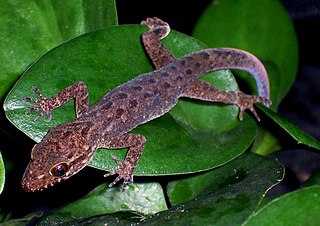
The Cyprinidae are the family of freshwater fishes, collectively called cyprinids, that includes the carps, the true minnows, and their relatives. Also commonly called the "carp family", or "minnow family", Cyprinidae is the largest and most diverse fish family and the largest vertebrate animal family in general, with about 3,000 species of which only 1,270 remain extant, divided into about 370 genera. They range from about 12 mm to the 3-m Catlocarpio siamensis. The family belongs to the ostariophysian order Cypriniformes, of whose genera and species the cyprinids make up more than two-thirds. The family name is derived from the Ancient Greek kyprînos.

Cyrtodactylus is a diverse genus of Asian geckos, commonly known as bent-toed geckos or bow-fingered geckos. It has at least 250 described species at present, which makes it the largest of all gecko genera.

Conoidea is a superfamily of predatory sea snails, marine gastropod mollusks within the suborder Hypsogastropoda. This superfamily is a very large group of marine mollusks, estimated at about 340 recent valid genera and subgenera, and considered by one authority to contain 4,000 named living species.

Dryinidae is a cosmopolitan family of solitary wasps. Dryinidae comes from the Greek. Latreille named this family because the first species was collected in an Oak plant in Spain. The larvae are parasitoids of the nymphs and adults of Auchenorrhyncha (Hemiptera). Dryinidae comprises approximately 1800 described species, distributed in 15 subfamilies and 50 genera.

Tardigrades, known colloquially as water bears or moss piglets, are a phylum of water-dwelling eight-legged segmented micro-animals. They were first described by the German zoologist Johann August Ephraim Goeze in 1773, who called them little water bears. In 1777, the Italian biologist Lazzaro Spallanzani named them Tardigrada, which means "slow steppers".
Gymnobela angulosa is a species of sea snail, a marine gastropod mollusk in the family Raphitomidae.
The Micronoctuini are a tribe of moths in the family Erebidae that includes about 400 described species. Typical species in the tribe have bifine hindwing venation and are smaller than those in other noctuoid moths. Micronoctua karsholti is the smallest of all species in the superfamily Noctuoidea.

Milnesium tardigradum is a cosmopolitan species of tardigrades that can be found in a diverse range of environments. It has also been found in the sea around Antarctica. M. tardigradum was described by Doyère in 1840. It contains unidentified osmolytes that could potentially provide important information in the process of cryptobiosis.

Milnesium is a genus of tardigrades. It is rather common, being found in wide variety of habitats across the world. It has a fossil record extenting back to the Cretaceous, the oldest species found so far is known from Turonian stage deposits on the east coast of the United States.

Milnesium berladnicorum is a species of Eutardigrade in the family Milnesiidae, native to Bârlad, Romania. Brownish in color, the species grows to a length of 400 micrometers. M. berladnicorum was named after the Berladnici, a tribe from Medieval Moldova.
Milnesium antarcticum is a species of Eutardigrades in the family Milnesiidae. This species differs from its cogenerate species mainly by proportions of its claws and buccopharyngeal apparatus.
Milnesium asiaticum is a species of Eutardigrades in the family Milnesiidae. This species differs from its cogenerate species mainly by proportions of its claws and buccopharyngeal apparatus.
Milnesium reductum is a species of Eutardigrades in the family Milnesiidae. This species differs from its cogenerate species mainly by proportions of its claws and buccopharyngeal apparatus.
Milnesium longiungue is a species of Eutardigrades in the family Milnesiidae. This species differs from its cogenerate species mainly by proportions of its claws and buccopharyngeal apparatus.

Turridae is a taxonomic family name for a number of predatory sea snails, marine gastropod mollusks in the superfamily Conoidea.
Vitjazinella is a genus of sea snails, marine gastropod mollusks in the family Mangeliidae.

The long-toothed pipistrelle is a species of bat of the genus Hypsugo. It is a small bat, with a length of 35.2–38.4 mm of forearm, and 5.9–7 mm of foot. It feeds on insects and has especially long canines compared to others of its genus.
Sturnira perla is a species of yellow-shouldered bat found in Ecuador.









